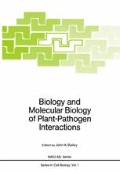Abstract
Early observations suggested that neutral polysaccharides from parasitic fungi could be universal elicitors of plant defence reactions [1]. However, more recent findings have indicated that unsaturated fatty acids and lipoconjugates are the active elicitors of phytoalexin accumulation in potato tubers [2]. But arachidonic and eicosapentaenoic acids are not universal elicitors either: they induce phytoalexin accumulation in potato and pepper, but not in twelve other plant species surveyed, including other Solanaceae, tobacco and tomato [3].
Access this chapter
Tax calculation will be finalised at checkout
Purchases are for personal use only
Preview
Unable to display preview. Download preview PDF.
References
Albersheim, P. and Valent, B.S., 1978, Plants, when exposed to oligosaccharides of fungal origin, defend themselves by accumulating antibiotics, J. Cell Biol., 78: 627–643.
Bostock, R.M., Kuć, J. and Laine, R.A., 1981, Eicosapentaenoic and arachidonic acids from Phytophthora infestans elicit fungitoxic sesquiterpenes in potato, Science, 212: 67–69.
Bloch, C.B., De Wit, P.J.G.M. and Kuć, J., 1984, Elicitation of phytoalexins by arachidonic and eicosapentaenoic acids: a host survey, Physiol. Plant Pathol., 25: 199–208.
Bouillant, M.L., Favre-Bonvin, J. and Ricci, P., 1983, Dianthalexine, nouvelle phytoalexine, de type benzoxazinone, isolée de l’oeillet Dianthus caryophyllus L. (Caryophyllacées), Tetrahedron Lett., 24: 51–52.
Ponchet, M., Martin-Tanguy, J., Marais, A. and Poupet, A., 1984, Dianthramides A and B, two N-benzoylanthranilic acid derivatives from elicited tissues of Dianthus caryophyllus, Phytochemistry, 23: 1901–1903.
Ricci, P., Bouillant, M.L. and Bernillon, J., Dianthalexin, a phytoalexin from carnation. Its involvement in induced resistance to Phytophthora parasitica Dastur. (Submitted).
Molot, P.M., Mas, P., Conus, M., Ferrière, H. and Ricci, P., 1981, Relations between capsidiol concentration, speed of fungal invasion and level of induced resistance in cultivars of pepper (Capsicum annuum) susceptible or resistant to Phytophthora capsici, Physiol. Plant Pathol., 18: 379–389.
Molot, P.M., Staron, T. and Mas, P., 1980, La résistance du piment à Phytophthora capsici. VIII- Induction de résistance et de capsidiol chez Capsicum annuum avec des fractions obtenues à partir de filtrats de culture et du mycelium de P. capsici, Ann. Phytopathol., 12: 379–387.
Gianinazzi, S., 1982, Antiviral agents and inducers of virus resistance: analogies with interferon, in: “Active Defence Mechanisms in Plants”, R.K.S. Wood, ed., pp. 275–298, Plenum Press, New York and London.
Fabre, I., Bruneteau, M., Ricci, P. and Michel, G., 1986, Isolement, composition et activité élicitrice chez l’oeillet de fractions extraites de la paroi de Phytophthora parasitica, Agronomie, 6: 35–45.
Fabre, I., Bruneteau, M., Ricci, P. and Michel, G., 1984, Isolement et étude structurale de glucanes de Phytophthora parasitica, Eur. J. Biochem., 142: 99–103.
Molot, P.M., Mas, P., Conus, M. and Ferrière, H., 1980, La résistance du piment à Phytophthora capsici. VII- Protection des organes foliaires après mise en survie sur filtrat de culture du parasite. Caractérisation des conditions d’expression du phénomène, Ann. Phytopathol., 12: 95–107.
Csinos, A. and Hendrix, J.W., 1977, Laminar necrosis, growth inhibition, and death of tobacco plants caused by toxic extracts of Phytophthora cryptogea, Phytopathology, 67: 434–438.
Bonnet, P., Poupet, A. and Bruneteau, M., 1985, Toxicité vis-à-vis du tabac d’un filtrat de culture de Phytophthora cryptogea Pethyb. & Laff., Agronomie, 5: 275–282.
Abad, P., Poupet, A., Ponchet, M., Venard, P. and Bettachini, B., 1985, Separation and quantitative assay of three pathogenesis-related (b)proteins from tobacco mosaic virus hypersensitive Nicotiana tabacum by reverse-phase high-performance liquid chromatography, J. Chromatography, 318: 417–426.
Author information
Authors and Affiliations
Editor information
Editors and Affiliations
Rights and permissions
Copyright information
© 1986 Springer-Verlag Berlin Heidelberg
About this paper
Cite this paper
Ricci, P. et al. (1986). Differential Elicitation Activities of Fractions from Phytophthora Spp. On Several Host-Plants. In: Bailey, J.A. (eds) Biology and Molecular Biology of Plant-Pathogen Interactions. NATO ASI Series, vol 1. Springer, Berlin, Heidelberg. https://doi.org/10.1007/978-3-642-82849-2_16
Download citation
DOI: https://doi.org/10.1007/978-3-642-82849-2_16
Publisher Name: Springer, Berlin, Heidelberg
Print ISBN: 978-3-642-82851-5
Online ISBN: 978-3-642-82849-2
eBook Packages: Springer Book Archive

